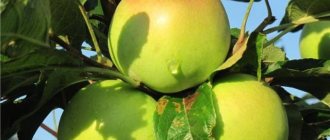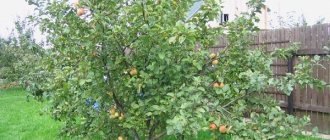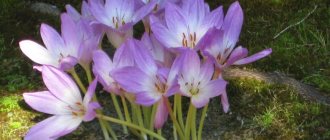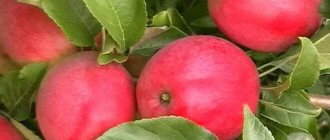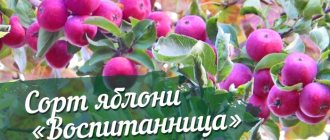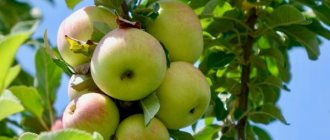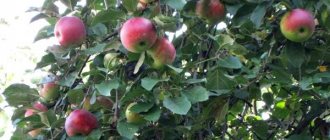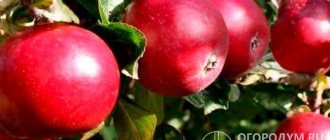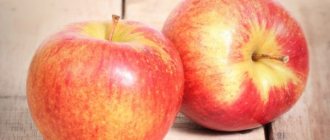Even in the ancient Bible, the apple is described as a seductive aromatic fruit that has a beneficial effect on the human body .
Throughout history, man has cultivated the apple tree and tried to improve its taste.
One of the oldest and most popular varieties known in our country is the Striefel or Streifling variety.
People also call it “Autumn Striped”. The history of the creation of the variety is not reliably known, but it is assumed that it came from Germany or Holland through the Baltic states. Considering this fact, Striefel is quite rightly considered a variety of folk selection .
Description of the variety
The variety is most widespread in central Russia, Belarus, and Ukraine; it also does well in more northern regions. It is also cultivated in other former republics of the union.
Advantages and disadvantages
- The main advantages are the longevity of the trees, good yield and excellent taste and marketability of the fruit. Renews well and recovers from damage.
- Among the disadvantages is that the plants take up a lot of space due to the large size of the crown. Late start of fruiting of young trees, some periodicity of fruiting. They do not tolerate drought well.
Tree height
The Striefel apple tree is a respectable tree with a height of 8 meters or more at maturity. The formation of the crown of young trees will allow growth to be regulated .
Crown width
- The trees are distinguished by a powerful, spreading crown.
- The width of individual trees reaches at least 8 meters.
- Powerful skeletal branches extend from the trunk at right angles, hanging down at the edge, and form a crown that looks like an overturned cauldron.
- Growth shoots and fruit twigs are intensively formed, thickening the crown.
Annual growth
During the summer season, plants give significant growth .
Fruiting is formed on three to four summer ringlets and at the ends of long rods of the second year.
This type of fruiting is called mixed.
Streifling (Strifel, Autumn Striped).
Lifespan
The lifespan of apple trees of the Striefel variety is more than a dozen years. Considering the late timing of the onset of fruiting , at the age of 15-30 years the tree is just reaching its maturity and for many years to come pleases the gardener with an excellent harvest of marketable apples.
Productivity
The average yield per tree is 90-100 kg.
Interesting! In the conditions of central Russia, at the age of 20-30 years, a tree produces about 300 kilograms of marketable apples or more.
Self-fertility
The quality of fruiting is improved by using pollinator trees at the rate of one tree for three apple trees.
Tasting assessment
Fruit:
- They have an excellent sweet and sour taste with,
- Rich in useful vitamins and microelements, amino acids, contain calcium, zinc, iodine, magnesium, manganese.
- Pectin content - up to 12%, sucrose - more than 10%.
Winter hardiness
High resistance to low temperatures is due to the origin of the variety and its acclimatization. Only young plants require protection in harsh winters
Disease resistance
The apple tree variety Striefel has good resistance to major diseases and pests:
- Parshe,
- fruit rot,
- Apple codling moth,
- To the sawfly,
- Aphids.
Scab on apples.
Advantages and disadvantages of the Streifling variety
The Streifling apple tree variety has been loved by gardeners for decades, not only for its unusual color. The advantages of the variety are:
- good yield (record recorded harvest - 429 kg per tree);
- excellent taste;
- suitability for consumption both fresh and processed;
- smooth and even surface of the fruit, favorable presentation;
- high frost resistance;
- Slightly affected by scab and codling moth.
The disadvantages of the Streifling variety include the following qualities:
- relatively late start of apple ripening;
- frequency of fruiting;
- relatively short shelf life of fruits;
- poor drought resistance.
Reviews
Alexander . I bought a plot with a large apple tree, which, according to neighbors, is about 40 years old. I wanted to cut it down, but I never got around to it. And after 3 years of an excellent harvest of fragrant, juicy apples, which we do not have time to eat with the whole large family, I would not exchange them for another.
Svetlana. We bought apple tree seedlings after we found the description and photo. Already in the third year, all began to bear fruit, except one, which turned out to be Striefel. We were immediately disappointed, but after another three years she made up for lost time, and every year she pleases with an excellent harvest. Now she is our favorite.
Anton Ivanovich. Excellent variety. From early autumn until the New Year we crunch on pleasant, slightly sour apples. Since childhood, I remember how my parents took Striefel to school with them. The photo and description of the variety are true. And so far there are no problems with the apple tree.
Apple tree Striefel
Anise makes excellent jam and jam. I will note that for Anise juice I pick the apples at the time when the seeds begin to color, but if I’m even a little late, then instead of juice there is puree. Breeder A is named as the author of the new variety. The main advantage can be considered that it can be grafted onto a vigorously growing rootstock and is not picky about very cold frosts and will not require you to cover it before the onset of cold weather. Another additional advantage of this tree is that cold winds will not harm it, so it is recommended to plant it in an open area so that the tree can receive all the sunlight and heat that is possible only with the onset of the growing season.
Apples are my favorite fruit. I've been growing it for quite a long time. Most of all I like the Nalivnaya variety. The apples are medium sized but very tasty. Ideally they should be yellowish.
Sections of the site
Then they are very sweet and aromatic. The green fruit is not yet ripe, but this does not mean that it cannot be eaten. So it is less aromatic and sour. My husband and I are novice summer residents. 6 years ago we bought a plot of land and built a house.
But we keep Antonovka apples for the longest time. They are stored until winter, in winter we usually eat up the rest of the apples and dry them in the dryer for compotes for children, and I also freeze them a little into slices - in winter I add them to charlotte. Apples retain their properties for a long time, I agree with you here!
We have them lying around almost until April and everything is fine. I wouldn't have thought they were that good before. But last summer we got sick, all the fruits became dark spots, I don’t understand what the problem is. Every spring we spray them, it used to help, but what happened now? Of all the above mentioned autumn varieties of apple trees, I give preference to the Aelita variety. The least demanding variety to grow. But I give preference because apples are stored very well in a dark room and this way you can eat them all winter.
Yes, I agree, the Aelita variety is not bad and its main feature is frost-resistant, which is very important for our places with cold winters. And she is also unpretentious to the soil; in principle, she doesn’t care what kind of soil it grows on, but to make sure there were fewer pests on the apple tree, we hung bird feeders and at the same time, in addition to food, they eat all the parasites on the apple tree.
Apples are a storehouse of vitamins, everyone has long known this, be it summer, autumn or winter varieties. I think it is impossible, or rather difficult, to name the best variety of apples. And the names of the varieties are one more interesting than the other: Lyubava, Uslada, Solnyshko, Skala, Gift to Gardeners... The most important thing is that apples are a healthy fruit with excellent taste. I love apples! In my opinion, all types of apples are very healthy. They just differ in taste and storage.
leave a comment
We have pear trees growing in our dacha. Very tasty apples. The wife leaves them for the winter. We store them in the cellar and they are always fresh.
Features of planting and caring for an apple tree
Proper planting of seedlings is designed to ensure good survival rate, which will ensure sufficient growth and development of plants in the future .
Landing
Deadlines
Autumn and spring planting is used.
It is very important not to waste time , since during autumn planting premature frosts can damage the seedlings.
It is better to plant in late September - early October so that the plant has time to gain a foothold in the ground.
Spring planting should be carried out at the end of March - the first half of April before the buds begin to bloom.
Advice! In the southern regions, winter planting is most favorable.
Technology
Planting pits are prepared in advance, 5-7 days in advance:
- The diameter of the hole is 100-120 cm, the depth is 60-80 cm. This size will allow the formation of a fertile layer for the roots.
- The lower infertile layer from the pit is laid separately.
- The hole is filled one third with a loosened fertile layer, the rest is mixed with two to three buckets of rotted manure.
- Add mineral fertilizers: potassium sulfate 4 tbsp. l. and 1 glass of superphosphate.
- Wood ash is added to neutralize the soil.
- The soil is filled to the middle of the hole and a seedling and stake for garter are placed in the center.
- The planting hole is filled with soil so that the root collar is above the ground level.
Features of cultivation
Young tree.
Shtrifel is an unpretentious variety, accustomed to the Baltic natural conditions , develops better and gives a good harvest on moist, fertile, warmed soils.
Sandy soils with insufficient watering have a bad effect on the yield level.
Agricultural technology
The main agrotechnical measures are:
- Feeding,
- Protection from pests and diseases.
It is enough to carry out three feedings during the season :
- In May - 0.5 cups of urea per 10 liters of water;
- In June - a complex of microelements;
- In August - per 1 sq.m: 20g of superphosphate and 30g of calcium chloride.
Advice! In July, the tree trunk circle can be sown with green manure plants and used as additional feeding.
Protection against pests and diseases includes preventive measures and chemical means of protection with copper-containing preparations:
- "Inta-vir"
- "Karbofos"
- "Iskra M" and others.
As folk remedies , planting chamomile, garlic, and marigolds near apple trees is used, and for spraying, decoctions and infusions of wormwood, tansy, parsley, hot pepper, and pine needles are used.
Pruning and crown formation
The large, spreading crown of an apple tree from the first years of life requires constant formation:
- Shoots directed into the crown and thickening it are removed,
- As well as branches with signs of disease.
Pruning rejuvenates adult plants, cuts off old branches, and creates conditions for the regrowth of young shoots.
Pollinator varieties
The variety is self-pollinating , but to improve fruiting, other varieties are used as pollinators: Antonovka, Papirovka, Welsey, Zelenka Dneprovskaya.
How to deal with diseases and pests
In early March, as soon as sap flow begins, begin processing Striefel for the purposes of prevention and pest control. We divide it into 3 stages:
- In mid-March and early April, we use Bordeaux mixture, solutions of copper and iron sulfate (5%) or any broad-spectrum fungicides.
- We spray the apple tree a second time at the moment the buds swell. By this time, the insects are already fully armed, we meet them with insecticides:
- Binon,
- Actocide,
- Detox.
- We spray the third time after flowering. Tree pests are dangerous at this time: scale insects, bark beetles, mites. Green foliage and apples are loved by caterpillars and beetles, aphids and moths. We use Zolon, Pirimix. In the fight against ticks we use:
- Iskra-M,
- Nitrafen,
- colloidal sulfur solutions.
The Striefel apple variety is resistant to diseases such as scab, but not 100%. He also suffers from parasitic diseases and is severely affected by fruit rot and powdery mildew. Striefel is slightly susceptible to bacterial cancer. The infection rate ranges from 35 to 50% and develops in 20% of apple trees.
In addition to treatment with copper-containing and biological products, the set of disease prevention measures must include:
- removal from the tree and destruction of rotten fruits;
- protecting apples from damage during harvesting;
- autumn digging of tree trunk circles.
A good technique that protects Striefel from frost, sunburn, and increases resistance to disease is whitewashing the trunks and branches. This is done in the fall (from October to November). Whiten with chalk (2 kg per 10 l of water) with the addition of copper sulfate (100 g per 10 l of water), wood glue (20 g per 10 l) or clay (2 kg per 10 l).
Drying of the tops and individual branches of an apple tree is called dry top. Striefel sometimes suffers from this disease. There is a proven recipe that tells how to “revive” a tree using a salt solution. It was popular at the beginning of the 20th century and published by the Moscow publishing house "Terra" in 1996 in "Everyday Gardener's Recipe" edited by P. Steinberg. Here he is:
Drill a hole along the radius of the tree trunk to the very core. A tube is inserted into the resulting hole and connected to a rubber tube of an Esmarch mug filled with 1.5 liters of saline solution (1:1). The mug is hung at a height of one and a half meters. Gradually the tree absorbs the liquid. After some time, the apple tree begins to be covered with fresh foliage. This is how more than one apple tree was saved.
Features of ripening and fruiting
Beginning of fruiting
To get the first fruits, you need to be patient.
The apple tree begins to bear fruit 5-7 years after planting , the yield increases gradually, and a full harvest can be obtained in 8-9 years.
Deadlines
Blooms
The apple tree blooms , depending on the region and weather conditions, from the beginning to the middle of the last ten days of May.
Buds:
- Light pink color,
- The white ones open up and appear,
- Quite large cups of overlapping, rounded petals.
Fruit ripening
The variety matures in autumn and reaches ripeness by early September.
Fruit storage
Fruits picked in a timely manner are stored at the optimal temperature in the refrigerator for no more than 3 months , and then they begin to sharply lose moisture and wither.
Attention! Delay in picking apples significantly reduces their shelf life.
Features of fruiting
The fruits of the Striefel apple tree are homogeneous.
Young apple trees produce a harvest annually ; minor periodicity may appear after the age of 20 years.
The Striefel apple tree pleases with fairly uniform, large fruits with good marketable qualities:
- More often they are round, slightly conical in shape.
- The weight of the fruit depends on the presence of moisture and is 170 grams or more.
- At the base there are small ribs on top, and sometimes there is a long longitudinal seam.
- Overall, the surface is quite smooth, slightly glossy.
- Ripe fruits are greenish-yellow in color, on the sunny side they have pronounced stripes of orange-red or brownish color, thin-skinned with a waxy coating.
- The pulp is yellowish, pinkish under the skin, slightly loose, but juicy.
Subspecies and options
Breeders are constantly working to improve apple tree varieties in order to preserve their advantages as much as possible and reduce their disadvantages . The Striefel variety did not stand aside either.
On a dwarf rootstock
On dwarf rootstocks, fruiting begins in the third year.
The durability and resistance of the variety to environmental influences is preserved in plants on a dwarf rootstock .
They are much easier to care for and also reduce harvesting costs.
Apple trees on a dwarf rootstock have an earlier start to fruiting, but the yield per tree is lower than that of tall plants. They are less winter-hardy and durable .
Schnittel red
As a result of development, a variety of apple tree appeared - red strifel.
It has the same quality characteristics as yellow.
A distinctive feature is the more saturated red color of the fruit peel, corresponding to the name of the shade
Apples covered with a pleasant waxy coating have a good presentation .
The fruits develop on long stalks and are attached quite firmly; when overripe, they do not tend to crumble.
Columnar
There is no columnar Striefel apple tree. Below we give general information about columnar apple trees.
To speed up the onset of fruiting and facilitate care, breeders create columnar trees:
- They lack lateral branches ,
- Fruit formations (rings and twigs) are formed densely along the tree trunk, which reaches a height of 2.5 - 3.0 m.
The ease of caring for columnar apple trees does not always compensate for the lack of yield compared to traditional agricultural technology.
Growing in regions
The Striefel variety has good winter hardiness, which is rated as above average, especially in mature plants.
Even in harsh winters, both the plants themselves and the flower buds are resilient. This circumstance makes it possible to grow apple trees in different climatic zones.
Considering that the origin of the apple tree is Baltic , it does well in a similar climate:
- In Belarus;
- In outskirts of Moscow.
Moscow region
With sufficient precipitation on loamy and soddy-podzolic soils, adult plants practically do not need watering .
Volga region
On lighter soils and in the southern regions, such as in the Volga region, the apple tree requires abundant watering , as it has a low drought resistance.
Important! Due to the fact that the apple tree has a powerful root system, watering should be thorough and deep. Superficial moisturizing will not give the desired effect.
Planting an apple tree seedling
In the southern regions, attention should be paid to protection against the codling moth.
Leningrad region
Despite the high resistance to scab, in rainy weather conditions in the northern region, individual fruits and leaves may be affected .
More work should be done here to prevent the development of fungal diseases.
Striefel apple variety - harvesting and storage
Streifling apples begin to ripen at the end of August in the southern regions and in September in the north. The ripeness of the fruit is indicated by the appearance of gloss on the skin and the coloring of the seeds in a dark brown color.
For storage, the fruits are removed from the tree without allowing them to fall to the ground. If it is difficult to remove apples from a large apple tree by hand, use fruit pickers. The simplest design is a cut plastic bottle attached to a long pole.
For storage:
- Look for apparently healthy, unbroken apples.
- They are placed in picture or wooden lattice boxes, sandwiched with thick paper or dry straw, sawdust from deciduous trees. The fruits should not touch each other.
- The fruits arranged in this way are put into storage, where the temperature is maintained at +2 +4 degrees and air humidity at 70%. The shelf life under such conditions is 2.5 months.
You can store part of the harvested crop for a couple of weeks in the refrigerator by placing the fruit in a plastic bag. Autumn Striped apples are an excellent unpretentious variety that can be grown in small gardens, thanks to the dwarf rootstock.
